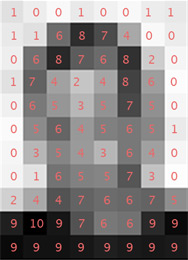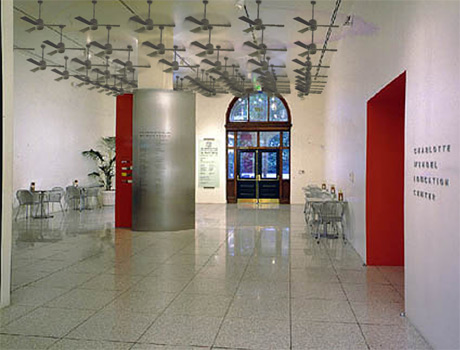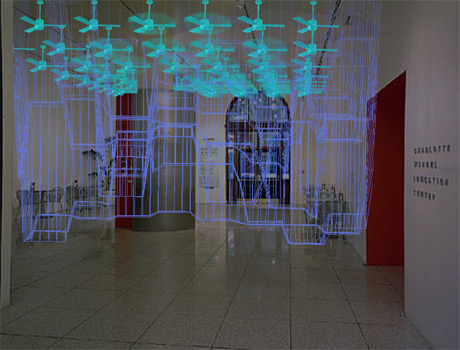3
Net-Gift Mood Systems
Proposal for ISEA2006 C4F3
Will Pappenheimer
Bio
Work Samples
System
III: Public Mood: Light Temperature
(Large Weddings Space with Piano)
Every 15 minutes Internet users will be able to change the overall light temperature
of the large cafe space. The overall light temperature will be based on a computational
distillation of information from a news stories described and imaged by Google
News. This system will utilize a dimmer controlled combination of red-blue-green
lights to achieve a variety of colors. Lights will be directed primarily at the
ceiling. If possible a computer station in the room will display the source and
results of the current entry. The concept is based on the tradition of the "mood
ring" which is composed of a material which changes color chemically based
on the body temperature of the ring bearer. In this case it is a public issue
which must be chosen by the Internet participant and then translated into color
temperature for the destination space. A simple computational model will be chosen
for the source news text and imagery which will then be translated into a color
temperature based upon varying models maintained by different cultures. This
system represents an offering and participatory mood encapsulating current issues
of public concern.
System
II: My Mood For You: Airflow Image
(Entrance Cafe Space with Red Doorway)
Every 15 minutes Internet users and visitors to the installation space will be
able to upload an image which represents their current condition which will then
be translated into the wind speeds of a grid of overhead fans. The image is thereby
gently blown down as variated air currents upon visitors in the installation
space. The technical process translates each uploaded image into a grayscale
grid of approximately 8 x 11 pixels. The grayscale level of each pixel is then
it translated into a 10% speed increment in the grid of fans (see example below).
Uploading can be done remotely from the internet or directly through a computer
station in the space. Visitors will be able to view the image which is currently
being translated into overhead aircurrents. This system is meant to access the
notion of image as encapsulatiing the mood or condition of the self. This condition
is then offered to the public as an immersive space. It mirrors the fundamental
sense and proliferation of websites dedicated to contributing a image of self
to the public space of the net. In this activity the image condition is sent
as a kind of message to unknown recipients.
System !: Community Space Issue: Lighting Design
(Hallway Tables Space)
Every 15 minutes, different Internet users will be able to redesign a color lighting
system surrounding the tables and chairs of
the cafe hall. Wall fixtures, standing
lamps and lighted room dividers purchased from IKEA will serve to divide chair/table
combinations into sections providing intimacy for cafe goers. Each light will
be outfitted with a lighting system capable of changing into 4-7 colors. From
an Internet interactive diagram (see example below) Internet participants will
be able to design a lighting arrangement which will then the immediately executed
in the actual architectural space. The results will be visable through a webcam.
Internet participants can create different moods or arrangements of emphasis
in certain areas. This system represents
a caring gesture towards individuals
and the cafe as a collective space, a space which also offers itself to the community
of
the internet.
Intro:
This
project proposes 3 Internet controlled atmospheric mood systems for the
ISEA2006 C4F3 spaces in the San Jose museum. Each represents a variation
of net-gift
or net transfer of remote concern translated telematically into spacial
lighting and airflow. The installations transform the directives of surveillance,
home
automation and open-sourced Internet applications into possibilities for
network participation in architectural mood. In the process image is translated
into
immersive airflow, news is translated into light temperature and an individual
design sensability becomes public color space. The works explore the possibilities
of redirecting economies of control into caring or gift economies. Distant
optical relationships merge with tangible corporeal room conditions.
Image
uploaded to website is simplified and reduced into 10 levels of grayscale
Levels
of grayscale are transmitted to 10% levels of fan speeds- image becomes vertical
airflow
visualization
of fan airflow image moving downwards
simulation
of 88 fans installed in cafe ceiling
simulation of lighting installed in cafe
interactive
internet map for remote changing of cafe lighting
Technology
and Installation
The systems will be work through an interlocking system of Flash interfaces,
X2Web and XTension software, and X10 home automation hardware. The system is
based on commercial software and hardware which is robust and reliable. PHP
programming with the host website will monitor one user at a time and a 15
minute time period for internet users which allows others to access control.
Lighting from IKEA will form the basis of the one of the systems: the Rederi
sconce, the Dunker floor lamp room divider, the vedium floor lamp and the Samtid
floor lamp. Color changes in the lighting systems will be achieved through
combination arrays of red-blue-green bulbs mixing additively. A MacIntosh computer
will be needed to run each system.
The systems are intended to surround, intersperse and fill the ceiling of each
of the three Museum public spaces. However, the projects are scaleable and
can be simplified to accommodate cost and limited conditions. One or two Mood
System room installations can be considered if all three are not equally feasible.
Wiring will be installed as temporary, using methods for safety relative to
each situation.
The artist will present for installation and the duration of operation and
will bring at least one assistant to help with construction.
simulation
of changing temperature lighting installed in large cafe ceiling





